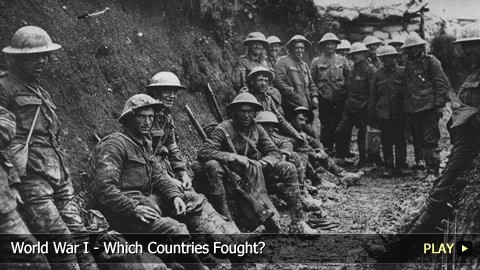World War I - Which Countries Fought

advertisement
VOICE OVER: Rebecca Brayton
After the heir to the Austro-Hungarian throne was assassinated in 1914, it was only a matter of months before war broke out. In an effort to exert control over the Balkans, Austria-Hungary declared war on Serbia. This battle was meant to be a limited one; however, a web of alliances and colonies that spread internationally led to the involvement of practically the entire world. Ultimately, the Allies would be fighting the Central Powers in a war that would directly involve approximately 63 million across the globe. In Part 2 of our series on WWI, http://www.WatchMojo.com finds out who was fighting whom during the First World War.
Who Was Fighting During WWI?
A network of alliances and colonies that spread across the world helped shape the two sides of World War I. Learn who was fighting whom during this major military conflict.
Austria-Hungary vs. Serbia
After the assassination of Archduke Franz Ferdinand, Austria-Hungary declared war on Serbia in an effort to exert control over the Balkans. What was supposed to be a short and limited war between two countries having a dispute quickly escalated into a conflict few could have expected.
Germany vs. Russia
At this time, Serbia enjoyed an alliance with powerful Russia. Because of this, the Austro-Hungarian government looked to their German ally for support, in the case that Russia should become involved. Sure enough, after mobilizing its army in defense of Serbia, Germany declared war on Russia on August 1st, 1914.
The Triple Entente
However, as well as a fight with Russia, Germany and Austria-Hungary were also up against the rest of the Triple Entente. The Triple Entente was the name given to the alliance between France, the United Kingdom, and Russia. By August 4th, 1914, all three countries of the Triple Entente had declared war on Germany, and by extension were also at war with Austria-Hungary.
The U.K. and her colonies
When the United Kingdom entered the war, her colonies and dominions all became involved to different degrees. This brought Australia, Canada, India, New Zealand, and South Africa into the fray. Also, based on its military agreement with Britain, Japan joined the conflict on August 23rd, 1914.
Italy Takes a Side
At first, Italy declared a policy of neutrality, despite their connections to both Germany and Austria-Hungary by treaty. Italy claimed that because the actions of its allies were offensive, it did not have to respect obligations to either. Instead, the country joined the Triple Entente in war against Germany and Austria-Hungary the following year. The reason for the change of heart was 1915’s secret Treaty of London, which promised Italy significant territorial gains at Austria-Hungary’s expense after the war had finished.
The Central Powers
The Ottoman Empire was pulled into the conflict after harboring German ships that went on to attack a Russian port. Joining Austria-Hungary and Germany, together these countries became known as the Central Powers, along with Bulgaria, who entered the war in 1915.
The Allied Powers
The Allied Powers was the name given to the Triple-Entente side, as it saw more and more countries join alongside them. Romania and Portugal joined in 1916, as did Greece in 1917.
Uninvolved U.S.
One of the only world powers still not involved in the First World War by this point was the United States. The United Kingdom was concerned that they would actually join on the side of the Central Powers because of their anti-colonial stance and history with the British Empire.
The Zimmermann Telegram
However, the United States of America avoided the conflict until 1917. What changed that was a telegram sent from Germany to Mexico that was intercepted in January of that year. In what became known as the Zimmermann Telegram, Germany sought the help of Mexico in the event that the United States did join the war alongside the Allies. In return, they were promised support in reclaiming U.S. land that once belonged to Mexico. In combination with this, Germany’s policy of unrestricted submarine warfare began to threaten U.S. commercial shipping. On April 6, 1917, the United States of America declared war against Germany.
A Changed Political Landscape
When all sides were in place, over 63 million people were directly involved in World War I, with roughly 39 million for the Allies, and 24 million for the Central Powers. No war in history has altered the political landscape of Europe as this one did. Once-powerful empires fell, and new countries grew out of them. Political, social, and economic consequences were felt the world over, and left even uninvolved countries dealing with the consequences.


 0
0
 0
0
 report
report

2022 Timothy Kozma
“take away”
 0
0
 0
0
 report
report
